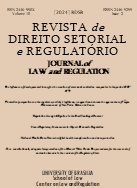Smart Regulatory Instruments in Airport Economic Regulation
Keywords:
Smart Regulation. Airport Concession Contracts.Abstract
[Purpose] The Brazilian Aviation Authority launched the 2020-2026 Strategic Plan and the Responsive Regulation Project, which include guidelines for "building a model of smart and responsive regulation, promoting development and competitiveness without unnecessary barriers or interventions" (ANAC, 2020). The main goal of the agency's project is to develop inspection models that align with responsive regulation and are therefore integrated into the ANAC´s inspection activities within its technical regulations. Additionally, while not the specific focus of the Responsive Regulation Project, the agency highlights the Supported Proposal instrument and the Sustainable Airports Project as examples of responsive approaches already implemented in the economic regulation of airports. This article aims to take a closer look at the regulatory methods found in smart regulation, which is a type of responsive regulation based on the theory put forth by Neil Gunningham (Gunningham, 1988).
[Methodology/approach/design] This is a comparative approach between the responsive initiatives in the economic regulation of airports in Brazil and the recommendations from the theory of smart regulation. The analysis is based on studying the historical development of regulatory modeling for airport concessions and the ANAC's Responsive Regulation Project.
[Findings] The study revealed several characteristics of smart regulation in the initiatives identified as responsive by ANAC. However, upon comparing the regulatory instruments with the theory of smart regulation, it is evident that the current model does not employ the regulatory technique proposed by the theory of regulation.
[Practical implications] The findings of this article can be applied to enhance the regulatory modeling of airport concession contracts in Brazil.
[Originality/value] The proposed analysis proves to be relevant for improving the understanding of the regulatory model adopted in Brazil for airport concessions.
Downloads
References
ARANHA, Marcio Iorio. As formas de autorregulação. JOTA, 26 de outubro de 2019.
ARANHA, Marcio Iorio. Manual de Direito Regulatório. Londres: Laccademia, 2022.
AYRES, Ian; BRAITHWAITE, John. Responsive Regulation: Transcending the Deregulation Debate. Oxford: Oxford University Press, 1992.
BRAITHAITE, John. The Essence of Responsive Regulation. 2011: 475-520.
—. “Responsive Regulation and Developing Economies.” World Development, 2006: 885-898.
CHAVES, Mauro Santiago. O Conselho de Aviação Civil e a Teoria Processual Administrativa da Regulação. Revista de Direito Setorial e Regulatório, outubro de 2000: 1-2-.
GUERRA, Sergio. Discricionariedade, Regulação e Reflexividade. Belo Horizonte: Forum, 2017.
GUNNINGHAM, Neil, e Peter GRABOSKY. Smart Regulation: Designing Environmental Policy. Designing Environmental Policy: Clarendon Press, 1998.
LOPES, Othon Azevedo. Fundamentos da Regulação. Rio de Janeiro: Processo, 2018.
MCLINSEY &COMPANY, INC. BANCO NACIONAL DE DESENVOLVIMENTO ECONÔMICO. Estudo do setor de transporte aéreo do Brasil: relatório consolidado. Rio de Janeiro. 2019
OCDE. Relatórios de Avaliação Concorrencial da OCDE: Brasil. Paris: OCDE Publishing, s.d.
ROCHA, Paulo Rios Matos. “Regulação da aviação civil brasileira: reflexos sobre enforcement, legalidade e juridicidade.” Revista de Direito Setorial e Regulatório, 2018: 61-80.
SINCLAIR, NEIL GUNNINGHAM and DARREN. Designing Smart Regulation. Paris: Organisation for Economic Co-operation and, 1998.
UNB. Estudo sobre abordagem comando-e-controle e teorias da regulação apoiadas em incentivos, com ênfase na regulação responsiva e seus fundamentos, inclusive o desenho das pirâmides responsivas, bem como sua aplicação direta no setor aéreo.
—. Estudo sobre correspondência entre modelos regulatórios apoiados em incentivos, em especial a regulação responsiva, e os princípios jurídico constitucionais e a fiscalização regulatória da ANAC. Disponível em https://www.gov.br/anac/pt-br/assuntos/regulacao-responsiva/material-de-apoio
—. Estudo com a proposta, para a temática escolhida pela Diretoria Colegiada da ANAC, de modelagem regulatória baseada em mecanismos de incentivos. Disponível em https://www.gov.br/anac/pt-br/assuntos/regulacao-responsiva/material-de-apoio.
Downloads
Published
How to Cite
Issue
Section
License
Copyright (c) 2024 Journal of Law and Regulation

This work is licensed under a Creative Commons Attribution 4.0 International License.
By submitting this paper to the Journal of Law and Regulation, I hereby declare that I agree to the terms of the Creative Commons Attribution 4.0 International (CC BY 4.0), available at http://creativecommons.org/licenses/by/4.0.


